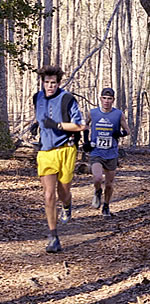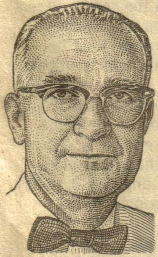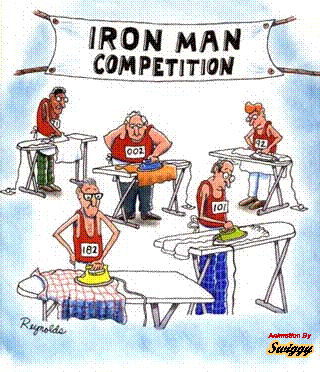





Ole Gossip Bulletin
Volume 13 Issue 1 & 2

STANLY COUNTY AMATEUR RADIO CLUB
BE IN THE KNOW!
WEDNESDAY ARES NET 146.985 - @ 9:00PM FRIDAY NET 147.390 + @ 9:00PM
CLUB MEETING FOURTH THURSDAY OF EACH MONTH
PRESIDENT
SECRETARY TREASURER
Lee Zehmer - W4ALZ Bill Greene -
K4VET Carl Starnes - W4EAT
|
Frequencies used by club members |
STANLY COUNTY AMATEUR RADIO
Where Do we Eat ?? and When Do We Eat ??
|
Breakfast Saturday @ 8:00 A.M. @ Stanfield Restaurant Monday @ 8:30 A.M. @ Stanfield Restaurant Talk-in 147.390 + |
Lunch Wednesday @11:30 A.M. @ Stanfield Restaurant Talk-in 147.390 + |
April 05
Club meeting topic:
Eat Out At Blue Bay (E Main) - Spouses are invited
Date: 4/28/05 Start Time: 6:45 pm to 7:00
pm..
May 05
Club meeting topic: HF - Correct
procedures for working HF or DX"
The difference in bands and when to use them
Presenter: Duane (W9ZM)
Date: 5/26/05 Stanly Community College (Snyder Building) @ 7:00 P.M.
June 05
Club meeting topic: Low Power Receive Presenter: Bill Tippett (W4ZV)
Date: 6/23/05 Stanly Community College (Snyder Building) @ 7:00 P.M.
Special Event: Field day - June 25 & 26 - Chuck Morehead Park – Albemarle, NC
Tid Bites
|
Field
Day |
|
New Club Members |
|
For
Sale
|
|
Articles By: Lee (W4ALZ) - Carl (W4EAT) - Bill (K4VET -Paul (KD4OZI)
|
From The Prez
There are so many ways to be involved in Amateur Radio. Some people love to make contacts with countries outside of the US; others like to be involved in public service; still others enjoy working satellites. One area that I have been having fun with recently is VHF Packet. While it is much slower than using the internet, it still is fun to be able to pass messages "unplugged" from telephone lines or cable. I could take my packet station, put it in my car, drive to the top of Morrow Mountain, and still pass messages. Packet also has an advantage in emergency situations. It is much faster and more accurate in passing emergency traffic than voice. I understand that there has been a rebirth in interest in Packet precisely because of this emergency application.
A packet station consists of a computer, a terminal node controller (TNC), a VHF or UHF radio, and an antenna. I bet most of you have three of the four necessary items. The only piece you would need to buy is the TNC. I have seen MFJ TNC's on ebay for around $30-$40. I use a PACCOM MK2 Tiny 2 that I bought for about $30 used. New ones might run you over $100. Once you have a TNC, you could also begin playing around with the Automatic Position Reporting System (APRS).
We will have a packet demonstration at Field Day, so I encourage those of you who might be interested to stop by and see how it works.
Speaking of Field Day, don't forget that it is June 25-26 and will be at Chuck Morehead Park this year. Make plans to attend.
73,
Lee - W4ALZ
[email protected]
----------------------------------------------------------------------------------------------------------------
Membership Status
With just 3 months left in this membership year I hope to be receiving renewals soon. As of March 24 the total members’ count is 52 including our Honorary Life Member W4WRK. We lost a very active member on January 11th. Joe, W4WWX, is and will be missed at club events. We did gain one new member and that is Timothy Lutz. Timothy isn’t licensed as yet but we hope his interest in Amateur Radio will continue until he has time to do some studying or attend a class somewhere. Of the 51 paid members 38 are paid through June of this year. Hopefully if you are among that group you will consider renewing soon. If you don’t make the club meetings and want to mail in your renewal, just make your check to Stanly County ARC and mail to PO Box 188, Stanfield, NC 28163. If you pay in cash away from a club meeting please put a note along with your money so that I will know (remember) what it is for.
If you are a member or want to become a member of the ARRL, please remember the club gets to keep a part of ARRL dues by renewing or joining through an affiliated club. The Stanly County ARC has been affiliated with ARRL since May 9, 1998. The club keeps $15 for new members and $2 for renewing members. You can save yourself money by joining for more than 1 year at a time but the club just keeps the $15 or $2 per application.
Stanly County ARC dues remain at $1 per month payable on a yearly basis with the membership year running from July 1st through June 30th. Anyone joining after January 15th will be requested to pay through June of the next year. An application form can be provided by K4VET, myself or KD4OZI. The ARRL dues are $39 for regular and $36 for seniors (65 and over). Additional family members may join for $8 but do not receive QST magazine. An application for ARRL can be downloaded from the web site below.
https://www.arrl.org/forms/member_general-99.html
Hope you see you at a club event soon and “bring money”.
73, Carl W4EAT
Treasurer
|
The
Richfield Troop 135
Round-up is submitted by
Bill Greene.
Simply "participate in a pack, Were you in scouting as a boy? Would you be willing to come to a meeting and share with the boys your experiences? Style of uniform? Activities? What was scouting like for you then? Contact Mrs. Anita.
Another new patch created this year is the Cub Scout
0utdoor Activity Award. Your
scout will display it on the fight pocket flap of his uniform. That's a
good sized patch. All ranks have a
particular
activity to complete. |
The scouts also choose activities from about a dozen such as hiking, overnight camping and swimming. The activities can be with the den, pack, or family. The 2nd Sunday of February was National Scout Sunday. All scouts were to meet at the Church that sponsors them to thank the church members for their support. Troop 135 is sponsored by the Town of Richfield. Thank you, Richfield, for your sponsorship. During March, Webelos and Boy Scouts will be working to complete their electrical and communications merit badges. Bill Greene, K4VET, a member of the Stanly County Amateur Radio Club, will guide the scouts building a crystal radio, and building a morse code keyer. March is also a good month for any scouts to make their presentations to the den and pack. The presentations fulfill require-, ments to earn achievements and arrow points. Always an interesting time. Plans are in the making for |
the troop's summer trip. More fun and details soon.
To help pay for the trip, the Troop has been offered opportunities to raise money. The scouts will be offering insect repellent and sunscreen type products through Mrs. Shonda. Also Mrs Amy making available candles. Profits generated go in to the account of the scout who sells to help pay his expenses. Fund-raisers are not mandatory activities for the scouts. However they do help defray the costs of your scout's chosen activity. Please keep in mind: if you have an empty computer ink jet cartridge, don't toss it. Donate it to Troop 135. We recycle. This is an ongoing fund raiser for the Troop. We also recycle old cell phones as well as aluminum cans. Every little bit helps. Thanks for your support.
f you want additional information
about Troop 135
please contact Mrs, Anita Thompson, 704-463-0467
|
73, K4VET -
Bill
Secretary
[email protected]
-------------------------------------------------------------------------------------------------------------
Thanks To Nil’s
Paul – KD4OZI
----------------------------------------------------------------------------------------------------------------------------------
Fun Run
The weather was a step above beautiful. The sky, wind and
weather (no rain) was fantastic for this years event. In the past years for
this event the weather was normally drearier and cold but not today. Our Stanly
County members turn out was very  good and the weather appeared to hold the
attention of all the operators for several hours Saturday. The 14/26 mile
station was manned by Med (K4HTJ), Larry (KF4HOP), Scott (KI4BWS) and Dan
(WB4RGS) at the 14/26 station. The 20 mile point was some what hectic but it
was more exciting to experience the final (last) runner at the 20 mile point.
The 20 mile station was manned by Don AE4AH, John (K3OF), Carl (W4EAT) and
myself. We had three new operators for this event, Carl, Scott and Dan. All
three vowed to be back for next years event and I will try and hold them to
their obligation. 20 MILE RUNNERS 134 runners --- 40 milers 94
runners
good and the weather appeared to hold the
attention of all the operators for several hours Saturday. The 14/26 mile
station was manned by Med (K4HTJ), Larry (KF4HOP), Scott (KI4BWS) and Dan
(WB4RGS) at the 14/26 station. The 20 mile point was some what hectic but it
was more exciting to experience the final (last) runner at the 20 mile point.
The 20 mile station was manned by Don AE4AH, John (K3OF), Carl (W4EAT) and
myself. We had three new operators for this event, Carl, Scott and Dan. All
three vowed to be back for next years event and I will try and hold them to
their obligation. 20 MILE RUNNERS 134 runners --- 40 milers 94
runners
Total Runner on our watch, 228, not sure the number of runners for the 8 mile
run. You know that we are there for communications and tracking is some how
tied in to the event, and the tracking seems to take more effort then just
communicating. The race was held on Saturday and then on Wednesday morning I
received the following message e-mail.
----------------------------------------------------------------
Paul, I think you were at the 20 mile station. The race officials have a
problem. They lost their master list and need our help. Can you send me the
following from your records:
The bib numbers of the 20 milers you have as not finishing 20 miles, either
scratches or drop-outs.
The bib numbers of the 40 milers that stopped at 20 miles (you may or may not have all of these).
What ever you can give me may help them.
Lionel
--------------------------------------------------
I sent Lionel, a message of the bib numbers that we had listed at the 20 mile marker. I showed a total number of 42 folks that had dropped out during the race as well as the number of 40 miles that had dropped out at our post. He received it with-in one hour after I had received his request for the information. I received the following reply from Lionel.
-----------------------------------------------------------------
Thought you might like to know you are appreciated!
Lionel
-----------------------------------------------------
For next years here are the fastest runners with year, name and times from 1991 to 2005.
|
40 Milers |
|
--------------------------------------------------------------------------------------------------------------------------------------------------
In December 1947, William
Shockley and his team of scientists came up with a solution to a problem vexing
their employers at AT&T Corp. At the time, voice was amplified over long
distances using vacuum tubes. The bulky tubes often overheated and broke down,
making long-distance calling expensive, Working at AT&T’s Bell Labs in Murray
Hill, N.J., two members of the team, Walter Brattain and John Bardeen, came up
with a
device made from a paper clip, two slivers of gold foil, and a slab of germanium
on a crystal plate. The contraption made it easier to transmit sounds with
clarity over a long distance. It was later dubbed the transistor. More than any
other technology, the invention unleashed the information revolution of the
late 20th century. Over time, it also carried the seeds of AT&T’s
demise.
The transistor, and
its subsequent improvement and miniaturization on silicon chips, made it
possible to store and distribute ever-greater amounts of info rmation.
That drove the development of computers, satellites, space exploration and
much of modern communications and electronics. Dr. Shockley moved to
California and founded a company that played a role in William
Shockley spawning Silicon Valley. The transistor invention won the Bell
Labs team the Nobel Prize in 1956.
rmation.
That drove the development of computers, satellites, space exploration and
much of modern communications and electronics. Dr. Shockley moved to
California and founded a company that played a role in William
Shockley spawning Silicon Valley. The transistor invention won the Bell
Labs team the Nobel Prize in 1956.
The resulting upheaval created new industrial fortunes-and destroyed others. AT&T was on the casualty list. After its forced breakup in 1984, it was slowly crushed by technologies that drove down the price of a long-distance call, and more recently by wireless calling and Internet phoning. In the past few years revenue has shrunk steadily, leaving it with valuable long-distance business customers but little else.
Once the largest phone company in the world, with a million employees when it was broken up by the federal government 21 years ago, a humbled AT&T agreed Monday to be acquired by one of its offspring, SBC Communications Inc., for $16 billion.
The transistor "shows how AT&T invented something that worked to sink it," says David Isenberg, who worked at the company's labs for 12 years until 1998 and is now an independent telecom analyst.
Along with the transistor, many of the inventions critical to the telecom upheaval today came at least partly from Bell Labs. They include the Unix computer operating system used in many corporate computer systems; cellular technology, which sparked the rise of wireless calling; and voice-compression technology, which helped make Internet calling possible.
But AT&T's monopoly status meant that it rarely exploited its inventions. Constantly threatened with breakup, the company agreed to put its transistor patents in the public domain and submitted to regulations barring it from businesses that didn't involve the telephone. Besides, executives felt little need to seize on the lab achievements since AT&T already enjoyed steady profits from its lock on the phone business.
"When I run into old Bell Labs people the first thing they say is, 'Can you believe what has happened?'" says Robert Lucky, a scientist and executive who worked at Bell Labs for 31 years until 1992. Even at the time of the breakup in 1984, he says, "the'feeling was that we had a network that was the envy of the world. No one could duplicate it." Instead, says Dr. Lucky, "what you had
AT&T Inventions Fueled the Tech Boom, and Its Own Fall
was big, new industries taking Bell Labs technology and turning it into lots of revenue."
The growth of Internet phoning was the "final nail in AT&T's coffin," says Mr. Isen-berg. The technology allows users to make calls through their high-speed Internet connections independent of the phone company. Some companies offer software to do this free. The inventor behind one of them, a Swede named Bastiaan Kleijn, is a former scientist at Bell Labs. Other companies charge a monthly fee for unlimited calls.
In the year before its sale to SBC, AT&T embraced Internet calling. But as the technology takes hold, it is unlikely companies will be able to charge much for it. "AT&T started the electronics revolution that in the end devoured it," says Eli Noam, the director of the Institute for Tele-Information at Columbia University.
The revolution began with Dr. Shockley and some silicon. During World War II British and American scientists had discovered signs that silicon could detect high-frequency radar signals, according to a PBS program and Web site on the history of the transistor, called "Transistorized." Silicon is a type of semiconductor- a substance that conducts only small amounts of electricity.
Dr. Shockley made some headway designing a semiconducting device to improve long-distance voice transmission, but ran into problems and handed his work to two members of his team, Dr. Brattain, , a physicist with a knack for building things in a lab, and Dr. Bardeen, an accomplished theoretical thinker. Shortly before Christmas 1947, the two made the breakthroughs that led to the creation of the transistor.
Immediately aware of the significance of their discovery, Dr. Shockley was happy, but also outraged that he had not been included in their important work. He subsequently built his own, sturdier version of the transistor within a month and insisted that only his name should go on the patent.
The other two scientists were shocked. "He called both Bardeen and I in, shortly after the demonstration, and told us that sometimes the people who do the work don't get the credit for it," recalled Dr. Brat-tain in an interview recorded in 1974 and preserved on the Web site. Drs. Brattain and Bardeen ultimately kept Dr. Shock-ley's name off the first transistor patent although his name was on later patents.
Drs. Brattain and Bardeen later became university professors. In 1956, Dr. Shockley moved to California where he started his own company, called Shockley Semiconductor, located near Stanford University.
Just a year later, exasperated with Dr. Shockey's difficult personality, eight of the original scientists at the company left to start their own company called Fairchild Semiconductor Corp. Veterans of Fairchild went on to form other powerhouse chip makers including Intel Corp., bringing to prominence the industry that gave Silicon Valley its name. (Dr. Shockley's reputation was later tarnished by his theories on intelligence and race. He died in 1989.)
Normally a company would seek to squeeze maximum licensing fees from a breakthrough patent. But AT&T was motivated to share its transistor technology. The U.S. government had filed an antitrust lawsuit in 1949, seeking to break up the company. "If AT&T sat on the patents it would give the Justice Department one more reason to break it up," says Michael Riordan, co-author of a book on the history of the transistor, called "Crystal Fire." The company had repeatedly argued that its monopoly-and the innovation its labs nourished-was for the public good.
Bell Labs agreed to share its knowledge on how to build a transistor with any interested party for just $25,000. Dozens of companies, including International Business Machines Corp., General Electric Co. and Texas Instruments Inc. paid the fee, according to Mr. Riordan. Another buyer was a Japanese tape-recorder maker called Tokyo Tsushin Kogyo. It developed a transistor radio along with other consumer electronics and soon found a name Americans could pronounce: Sony.
In 1956, AT&T signed a consent decree with the federal government that allowed it to keep its structure under which it sold both phone service and telephones themselves. In exchange, AT&T promised to stay out of other businesses and license its patents freely. AT&T's equipment arm, Western Electric, had to withdraw from selling sound equipment for film producers and movie theaters — giving up experience in a competitive market that would have proved useful later.
The decree also put the transistor patents in the public domain. As a result, while AT&T used transistors to improve the reliability and quality of the phone calls it relayed, it played little role in developing the integrated circuit. That fame and fortune went largely to Texas Instruments and Fairchild, which independently figured out a way in the late 1950s to fabricate and embed multiple, miniaturized transistors on a tiny silicon chip. Those advances led to the birth of the microprocessor, the engine of personal computers.
Keeping AT&T from selling to customers other than itself made it wholly unprepared for the day, in 1984, when it was no longer a monopoly and became free to compete like any other company.
"There was never any sense of urgency in the company because competition was absent," says Greg Blonder, an engineer and
executive at the labs for 17 years until 1999 and now a venture capitalist. "Whereas everyone else in the world saw the new technologies as an opportunity to upend the market, AT&T saw no reason to do this."
Cellphones were a major area where AT&T squandered a technology lead, and it wasn't because of government restrictions. Bell Labs scientists conceived of the cellular concept—the idea that a phone call could be moved from one tower to another as the caller moved—as early as 1947. Along with Motorola Inc., Bell Labs scientists helped make mobile telephones a commercially viable proposition in the 1970s.
In 1983 the Federal Communications Commission set guidelines for the rollout of cellphone service. An incumbent carrier would get one license in each market while the second would be up for grabs. At the time, AT&T was about to be split up, and it could have demanded that the new AT&T long-distance company be given the incumbent licenses. But Charles Brown, then chief executive, decided that the cellphone was largely a local business.
"He felt that it was logical that the cellular business should go to the Baby Bells," says Sheldon Hochheiser, AT&T's former historian, referring to the local phone companies spun off in the 1984 breakup. A study at the time by McKinsey & Co. predicted that by the year 2000 there would be 900,000 cellphone users in the U.S. Many thought the prediction was way too high. The actual number was more than 100-fold greater than the prediction. The licenses that Mr. Brown had decided not to seek turned out to be worth many billions of dollars.
Eventually AT&T realized it had missed the boat on cellphones. It bought a cellphone provider in 1993 but later spun it off as an independent company called AT&T Wireless. That company was acquired last year by Cingular Wireless, which is 60%-owned by SBC, and the AT&T Wireless name was retired.
AT&T was also well-positioned to become a powerhouse in computers at the time of its breakup. Some envisioned it as a competitor to IBM. "It turns out that knowing a lot about computers was different than selling them," says Mr. Hochheiser. AT&T was used to designing computers for itself, not outside customers. To jump-start the business, in 1991 AT&T bought computer maker NCR Corp. in a hostile deal worth $7.4 billion. The deal flopped and NCR was spun off five years later.
Inside AT&T, some played down the failure to seize new markets, believing; that new technology was driving growth in the company's core business. The fax machine, for example, was another innovation Bell Labs helped develop that ended up being manufactured and sold elsewhere.
1876: Alexander Graham
Beli invents the telephone, founds the company that becomes AT&T with two
financial backers.
1947: Three Bell Labs scientists invent the transistor, laying the foundation
for modern electronics.
1970: AT&T introduces customer dialing of international long-distance calls,
initially between Manhattan and London.
1984: Government breaks up AT&T. New AT&T retains long-distance business,
manufacturing and R&D; seven "Baby Bells" provide local service.
1996: AT&T spins off products and systems company, later named Lucent
Technologies, and computer company NCR.
2005: SBC
Communications announces it will buy AT&T.
Source: WSJ research
"AT&T as an equipment maker missed the fax machine," says John Zeglis, the former chief executive of AT&T Wireless who also served earlier as AT&T's president and general counsel. "But wow, did long-distance minutes boom. The theory was, give away the technology so it creates more usage for the communications path."
Now as AT&T finally prepares to vanish as an independent company, it leaves a vacuum in innovation and research that will be hard to fill. AT&T could afford to embark on long-run research because, as a telephone monopoly, it was the only phone company that would benefit. But in today's world of cutthroat competition, few companies can afford such an approach. (Lucent Technologies Inc. owns the bulk of the old Bell Labs, which focuses on developments with more immediate uses for Lucent.)
"Yes, phone calls were
very expensive and we got rid of a monopoly," says Mr. Riordan, the co-author of
the transistor history. "But this was a company that literally dumped
technology on our country. I don't think we'll see an organization with that
kind of record ever again."
Thanks Stake (K4WC) for bringing this to our attention..
-----------------------------------------------------------------------------------

 |

|


|
| Mr. I' am Pig |
HAMFEST 2005
April 2 - Union County ARC Hamfest, Union County, SC
17 - RARS Fest, Raleigh, NC (162 MILES)
16 - Catawba Val, HF & Computer, Morganton, NC (107 MILES)
29 & 30 SE VHF Society Conference, Charlotte, NC
May
7 - Upstate Hamfest, Spartanburg, SC
14 -
Rockingham County. Hamafest, Eden, NC
20-22 - ARRL National Conv/Hamvention, Dayton, OH (471 MILES)
21 Roanoke ARS Swap Fest, Williamston, NC
21 – East Cartolina Antique Radio Club, Greenville, NC
28 - Dur Hamfest @ NG Armory, Durham, NC (141 Miles)
June
11 - W-S Classic @ Dixie Fairgrounds, Winston-Salem, NC (79 MILES)
11 – Saturday Only RACKHamfest, TN ARRL Knoxville, TN (260 MILES)
18* - Tail Gate Party, Chester, S.C. (75 MILES)
July
2 - Firecracker Hamfest @ Civic Center, Salisbury, NC (39 MILES)
16 - Mid Summer Swapfest, Cary, NC (121 MILES)
30 – Waynesville Hamfest, Waynesville, NC (177 MILES)
August
7 -55nd Annual, Winchester HF, Berryville, VA. (178 MILES)
13 - 7th Annual CFARS Swapfest, Fayetteville, NC
13* - Tara HF & Computer Show, Huntington, WV (328 MILES)
September
3 & 4 - Shelby ARC Hamfest, Shelby, NC (76 MILES)
17 & 18 - VA Wesleyan, Virginia Beach, VA (341 MILES)
-----------------------------------------------------------------------------------
Nostradamus they weren't... (There was probably someone
somewhere who thought that duct tape would never catch on either.) from the Duct
tape Guys..
- British Parliment report on Edison's work, 1878.
The Telephone - "That's an amazing invention, but who would ever want to use one
of them?"
- Pres. Rutherford Hayes, 1876
Television - "People will soon get tired of staring at a plywood box every
night."
- Darryl F. Zanuck, head of Twentieth Century-Fox, 1946.
Computers - "There is no reason for any
individual to have a computer in their home."
- Ken Olson, Pres. of Digital Equipment Corp., 1977
-------------------------------------------------------------------------------------------------------
Carl are you sure that the Rotor cups were bad???

-------------------------------------------------------------------------------------------------------------------------------------------------------------
Our Stanly County ARC
participants
in the Iron Man contest


DECArea-12 - KD4OZI
Newsletter
4th Quarter 2004
Newsletter
3rd Quarter 2004
Newsletter
2nd Quarter 2004